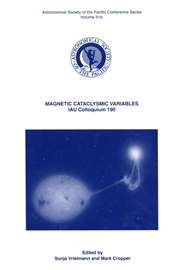No CrossRef data available.
Article contents
Inner Edge Drag by an Asynchronous Primary and Accretion Disc Structure in Close Binaries
Published online by Cambridge University Press: 12 April 2016
Extract
In this work a 3–D ‘Smoothed Particle Hydrodynamics’ ([1]; [4]; [5]) accretion disc is simulated where particles at its inner edge are dragged by a fast spinning compact central star, as in the case of the intermediate polars. The angular velocity of the central star is twice the orbital angular velocity ω o. This drag can be attributed mainly to viscous interaction in the dense compact star atmosphere, although magnetic coupling may also play a role.
Our simulations have been performed for a system with a primary (a white dwarf) mass M 1 = 1.3 M⊙, a secondary mass M 2 = 2.2 M⊙, a separation between the components (centre to centre) d 12 = 6.33 1011 cm and an orbital period = 1.7 d, the integration time being as long as ≃ 75 d. As in [2] and [3], we have considered quasi-polytropic structures with γ = 1.01. We adopt the term quasi-polytropic since we have in fact solved also an energy equation.
Information
- Type
- Accretion Discs
- Information
- International Astronomical Union Colloquium , Volume 158: Cataclysmic Variables and Related Objects , 1996 , pp. 117 - 118
- Copyright
- Copyright © Kluwer 1996

